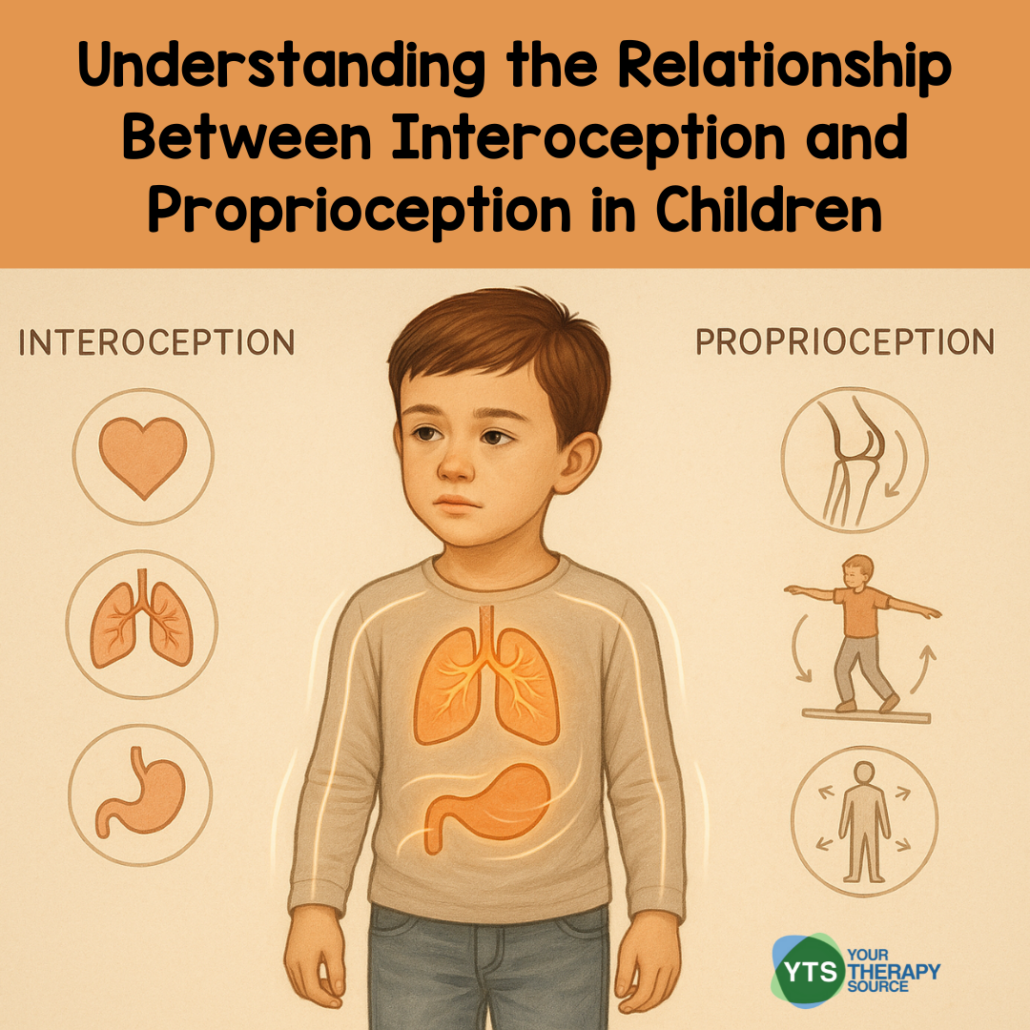Understanding the Relationship Between Interoception and Proprioception in Children
Children develop body awareness and emotional regulation through more than just sight, sound, and touch. Two lesser-known but essential sensory systems, interoception and proprioception, play a critical role in helping children navigate the physical and emotional demands of daily life. These systems influence how children move, how they manage their energy, and how they respond to internal sensations such as tiredness or frustration.
Research shows that these systems are more connected than once believed. In particular, some findings suggest that some difficulties traditionally viewed as proprioceptive, like misjudging effort or clumsiness, may in fact be linked to interoceptive processing. Understanding this relationship can help caregivers and professionals better support children who struggle with regulation, movement, or emotional awareness.
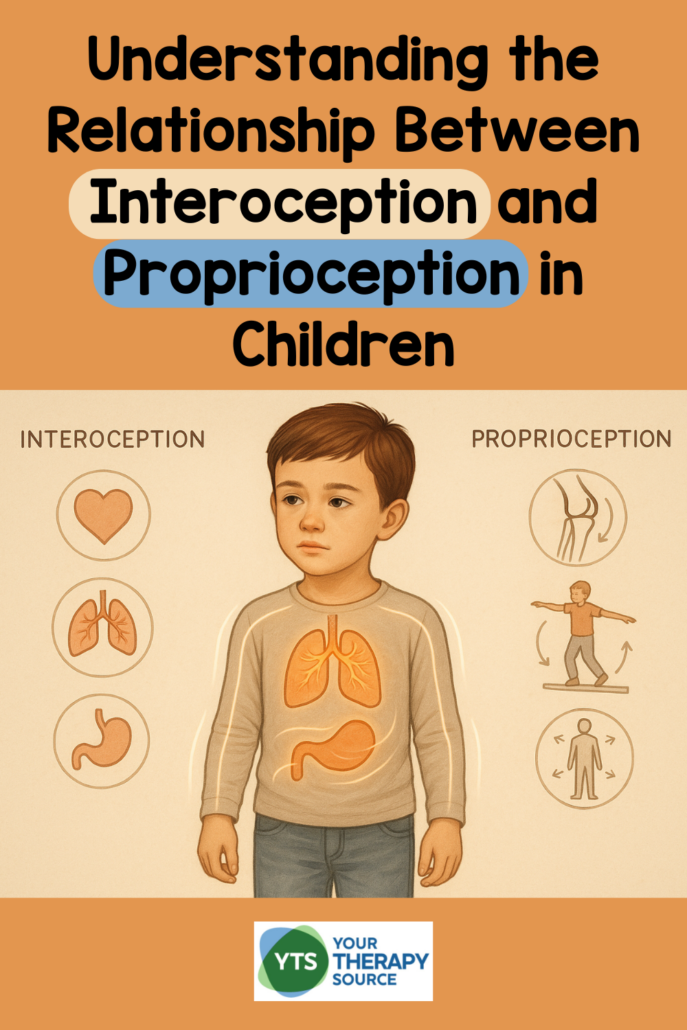
What Are Interoception and Proprioception?
Interoception is the ability to sense internal body states. It includes awareness of signals such as hunger, thirst, heartbeat, breathing, muscle effort, and emotional arousal. Interoception helps children know how they feel inside and guides responses such as resting, moving, or calming down.
Proprioception refers to the sense of body position and movement. It tells children where their limbs are without needing to look and helps them use the right amount of force for actions like writing, climbing, or jumping.
These systems often work together. When a child runs and feels their heart beating fast, breath quickening, and legs getting tired, they are using both proprioception and interoception to gauge effort, make adjustments, and decide whether to keep going or take a break.
How Are Interoception and Proprioception Connected?
A 2018 study by Murphy, Catmur, and Bird explored the relationship between interoception and alexithymia, a condition characterized by difficulty identifying and describing emotions. The researchers found that people with higher levels of alexithymia had reduced accuracy in a task involving muscular effort. Participants were asked to match the weight of a bucket using only internal cues—without vision or external feedback. Those with more alexithymic traits were less accurate in judging how much effort they were using.
Although the task seemed physical, the researchers classified it as interoceptive because it relied on sensing internal effort. This suggests that when children struggle to adjust force or coordinate movement, the issue may stem from how they perceive their internal body signals not just from poor motor planning or muscle control.
In other words, the ability to sense how much effort a task requires is not only a motor skill. It is also a form of interoceptive awareness.
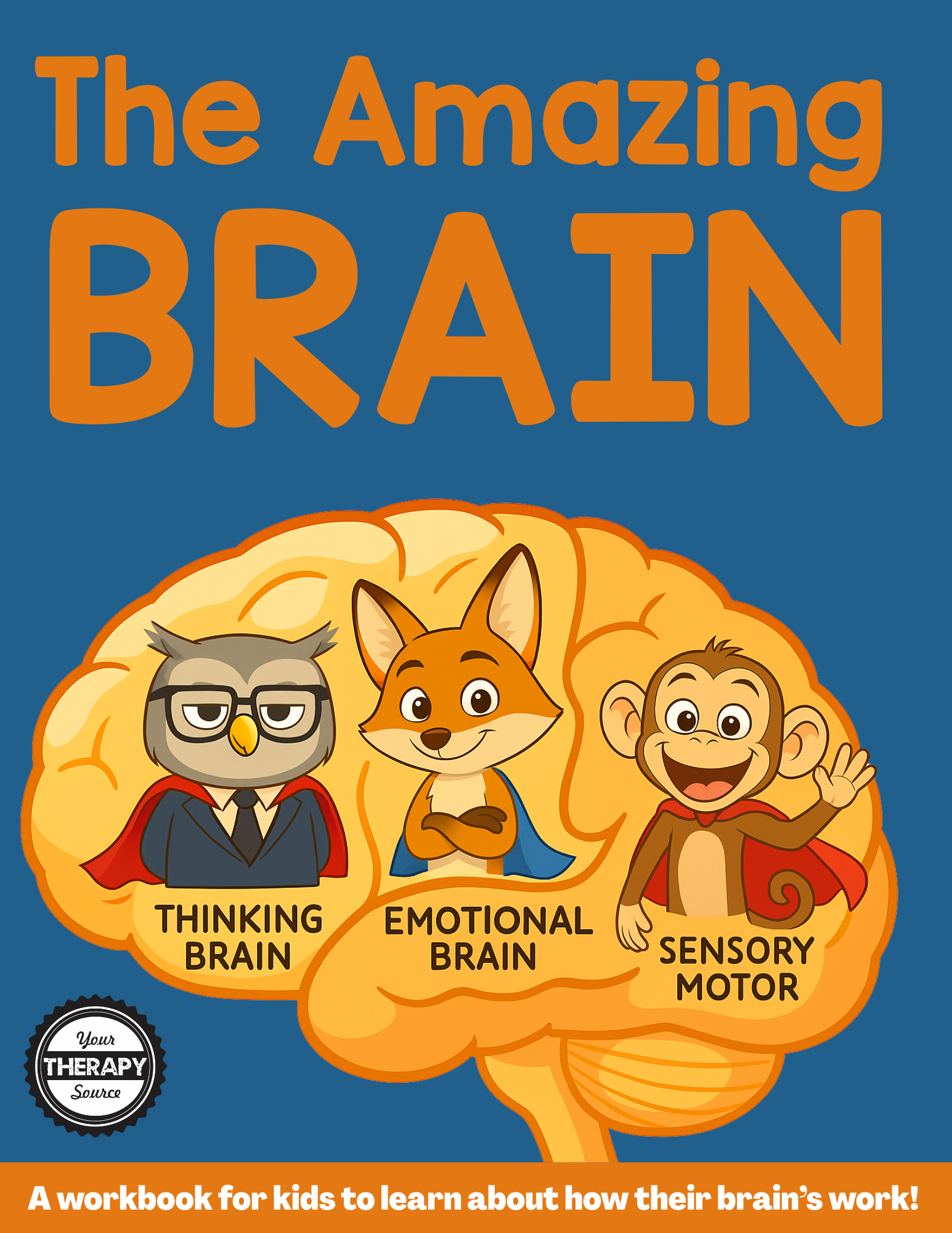
The Amazing Brain Workbook for Kids
Shared Brain Regions Between Interoception and Proprioception
Interoception and proprioception are processed through overlapping brain systems. These areas work together to help children form a clear sense of their body in space and how it feels during movement and rest.
Key brain regions include:
- Insular cortex
This region plays a central role in interoception. It integrates signals related to heart rate, breathing, muscle strain, and other internal states, bringing them into conscious awareness. The insula also supports emotional awareness, helping children connect body sensations to feelings like anxiety or calm. - Somatosensory cortex
This part of the brain processes touch and proprioceptive input from joints and muscles. It tells the brain where body parts are and how they are moving, supporting movement accuracy and force control. - Posterior parietal cortex
This region blends information from vision, proprioception, and interoception. It helps form the brain’s map of the body in space and guides planning, coordination, and balance.
When these areas are underdeveloped or disrupted, children may:
- Appear clumsy or have poor coordination
- Struggle with adjusting effort or force during tasks
- Seem unaware of fatigue or discomfort
- Overreact or underreact to physical and emotional sensations
- Rely heavily on visual cues instead of internal feedback
Recognizing that these systems share common brain structures helps explain why challenges in one area often impact the other.
Signs in Children with Difficulties in Interoception and Proprioception
Children with difficulties in interoception and proprioception may:
- Avoid physical activities that require strength, balance, or coordination
- Use too much or too little force when writing, playing, or handling objects
- Struggle with balance or appear unsure of their body in space
- Show limited awareness of their own fatigue, hunger, or tension
- Become overwhelmed in busy or physically demanding environments
- Have difficulty labeling or managing emotions that stem from internal body cues
These behaviors may be misinterpreted as behavioral problems, sensory seeking, or general motor delays. However, they can also be signs of a disconnect between the body and brain’s internal communication systems.
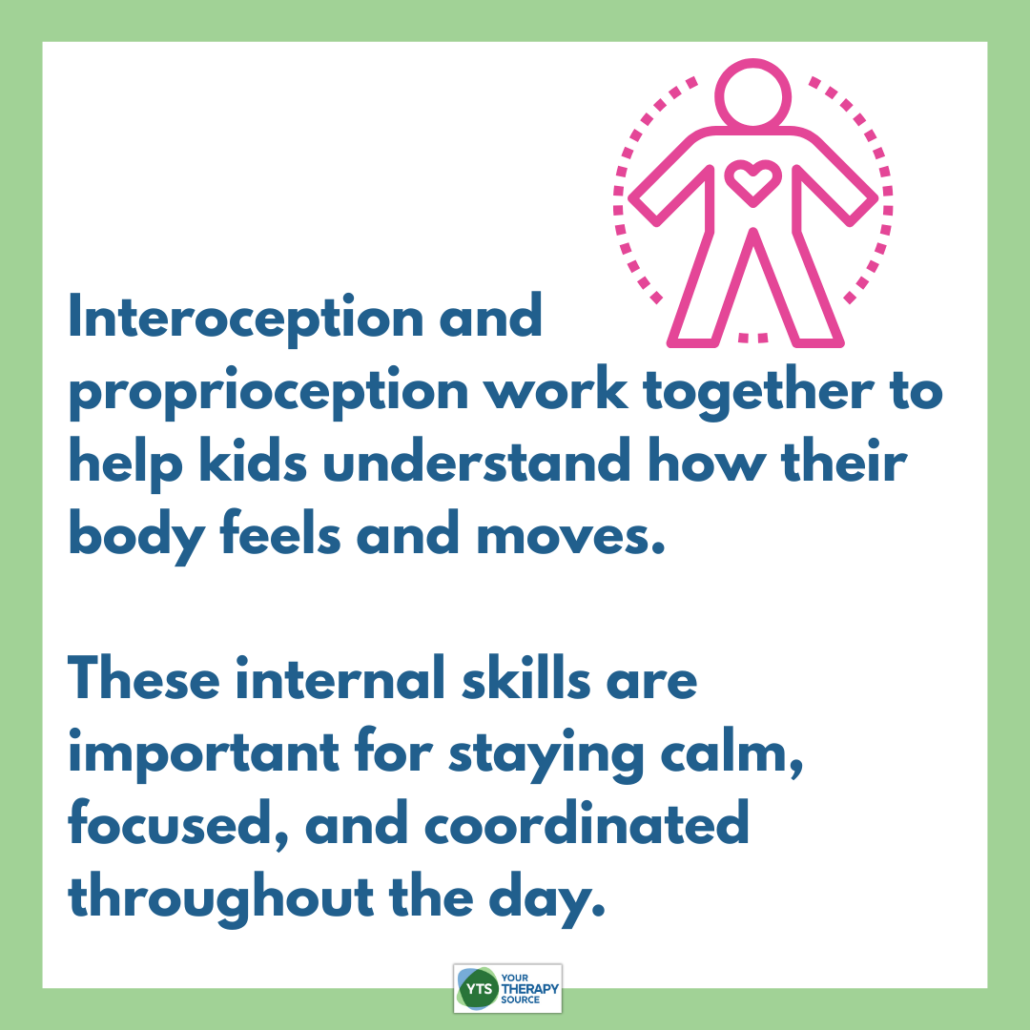
Strategies to Support Children
Therapists, educators, and caregivers can use the following approaches to help children strengthen their interoceptive and proprioceptive awareness.
Use effort-based activities with reflection
Have children push weighted carts, squeeze putty, or carry objects of varying weight. Follow up with questions such as:
- Did that feel easy or hard?
- Can you feel your arms working?
- Which object felt heavier?
Incorporate body check-ins
After movement or during transitions, pause and ask:
- Is your heart beating fast or slow?
- Are your legs tired or ready to go again?
- Can you feel your breath moving in your belly?
Practice calming routines that involve the body
Teach breathing, stretching, or body scanning exercises. Use prompts like:
- Where do you feel calm in your body?
- Can you notice any tension in your shoulders or hands?
Use visual aids and sensory cues
Provide mirrors, body maps, or illustrated charts to help children link what they see with what they feel. Allow space for quiet reflection after movement-based tasks.
Model and teach body-brain language
Use clear, simple phrases such as:
- Your body sends messages to your brain to help you decide what to do.
- Sometimes your body gets tired, and that’s your signal to take a break.
- When you listen to your body, you can feel more in control.
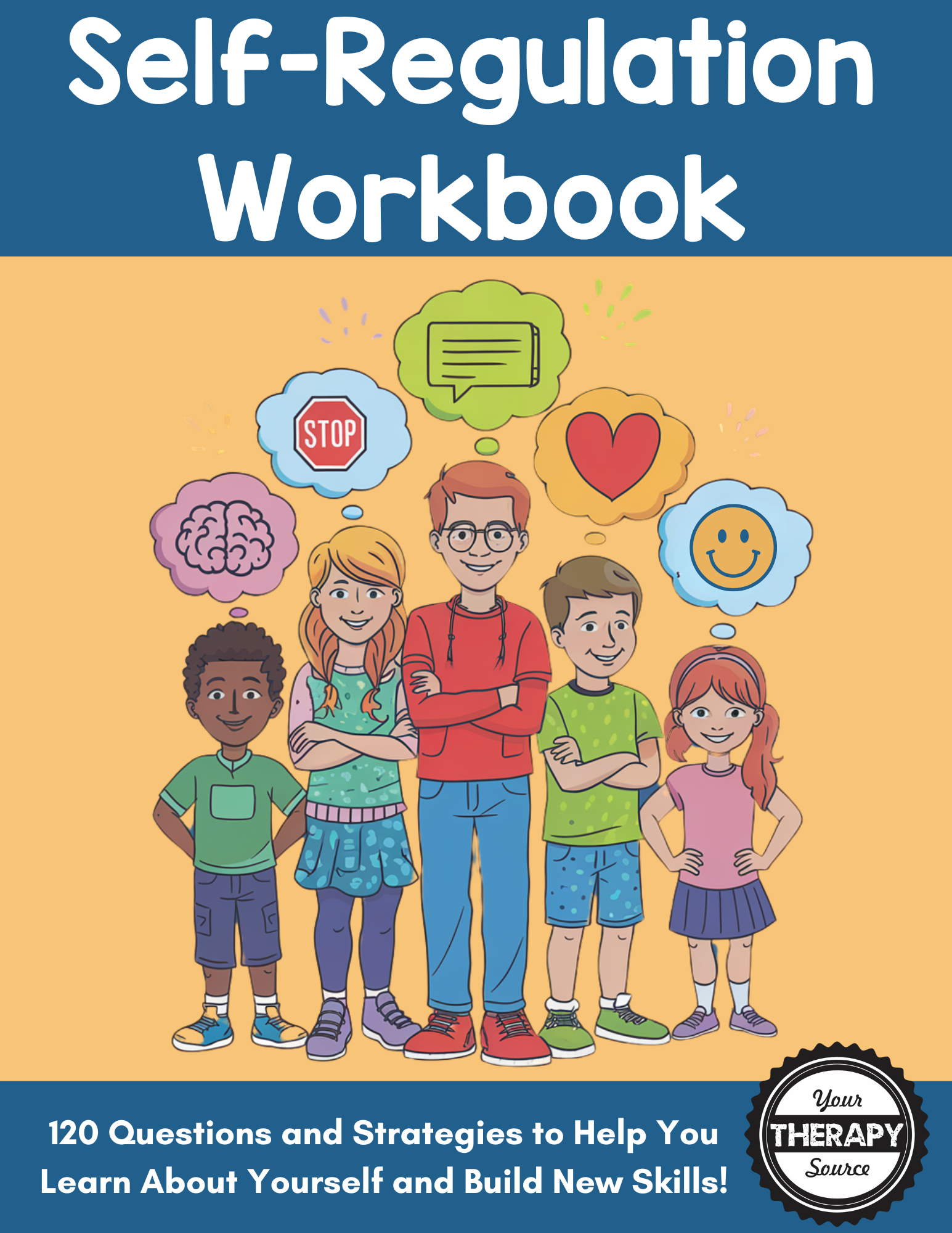
Self Regulation Workbook – Learn About Yourself
When to Seek Help
If a child consistently struggles with coordination, body awareness, or emotional regulation, it may be helpful to talk to a pediatrician. An evaluation by an occupational therapist or physical therapist can identify underlying sensory processing challenges. These professionals use play-based movement, sensory activities, and body-based strategies to support both proprioceptive and interoceptive development. Early intervention can improve not only physical skills but also emotional resilience and self-regulation.
Evidence suggests that interoception and proprioception are more closely linked than previously thought. Tasks that seem motor-based may actually depend on a child’s ability to sense internal effort and body state. By supporting both systems together, professionals and caregivers can help children build stronger self-awareness, movement control, and emotional balance.
Reference
Murphy, J., Catmur, C., & Bird, G. (2018). Alexithymia is associated with a multidomain, multidimensional failure of interoception: Evidence from novel tests. Journal of Experimental Psychology: General, 147(3), 398.
